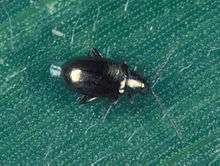Chaetocnema pulicaria
Chaetocnema hortensis, also known as the corn flea beetle[1] and clover flea beetle,[2] is a species of flea beetle from Chrysomelidae family, found in Texas, USA[3] and Canada.[4]
| Chaetocnema hortensis | |
|---|---|
 | |
| Scientific classification | |
| Kingdom: | |
| Phylum: | |
| Class: | |
| Order: | |
| Family: | |
| Genus: | |
| Species: | C. hortensis |
| Binomial name | |
| Chaetocnema hortensis F. E. Melsheimer, 1880 | |
Description
The species is black in color, with orange legs and antennae.[3] Their size is quite small, about 1⁄16 inch (1.6 mm) long.[5]
Species lifecycle
The females lay eggs in soil, which has plants growing nearby. The eggs hatch in 7 to 14 days into larvae. While in their larval stage, their small, worm-like bodies are white. The larvae feed especially on plants' roots, causing serious damage. Then, they transform into pupae, and a week later, into adults.[5]
Pest
The species is known for causing damage to crops. The damaged plants include sorghum, soybeans, sweet corn, small grains, and some vegetables.[6] They feed on both sides of a leaf (upper and lower parts), including epidermis and the veins. They also transmit Stewart's wilt; by removing the leaf tissue from the plant, they open a wound which allows the disease to begin spreading from plant to plant. The disease organism is Pantoea stewartii.
References
- "Chaetocnema pulicaria (Corn Flea Beetle)". Zipcode zoo. Retrieved 23 February 2012.
- Second common name
- "Chaetocnema pulicaria". Bug Guide. Retrieved 24 February 2012.
- "Chaetocnema pulicaria". Discover life. Retrieved 24 February 2012.
- "Chaetocnema pulicaria". Entomology.cornell.edu. Retrieved 24 February 2012.
- Pest